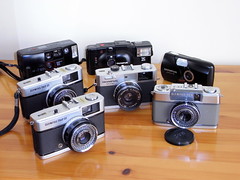Along the way I've acquired lots of cameras. I use them and I like them, wondering what each one can do, how I'll use it, and in some cases, just because I want one (step forward Leica M4-2...).
As I've been photographing since my teen years, back in the late 70's, I'm the 'generation' of photographers who have shot with film, and transferred over to digital. To my chagrin, I've never mastered a foreign language ( I'm very envious of those who have), but photographically, I've happily learnt how to switch from film use to digital shooting, from dev' times to pixels, darkroom to Photoshop. Easily enough new knowledge to be decently fluent in French or Italian, but there you go.
Early digital cameras were a marvel, but a bit of a struggle....the Agfa 1280 costing £800, boasting a class leading 1 megapixel resolution, with several seconds write time between shots (on a 128mb Smartmedia card, remember them?), truly a spec' that most mobile phones would laugh at now - if mobiles could laugh that is.
And the Nikon D1, a technological revalation which was worth more than my company car, so I was rigid with fear every time I slung it onto my shoulder (gently placed and held on too tightly more like). Took lovely magenta tinted photos too, saved onto a 256mb card I bought for £120, back when £120 was almost a cheap holiday in Crete.
The fear of deleting everything haunted every button press and mouse click, until, like learning to drive, it all suddenly became second nature.
What didn't come so easily was shooting through the cropped viewfinder of the D1, and every other dSLR. We took the 'widescreen' viewfinders in film SLRs for granted, and now had to work like looking down an tunnel.
After years of working with digital SLRs, with which I was now totally familiar and comfortable with, I began to think about my old 35mm cameras, tucked away unused in camera bags.
I dug out the Pentax MX I started my career with, and the Nikon FM's I moved onto. Wow were they small and light (especially the MX) compared to the D2h I was now using. The lenses felt so well made, and of course they were manual focus, but that felt great - smooth to use and 'in control'. But the single greatest revelation, forgotten over the years, was the seemingly panoramic viewfinder. It was like going from a 14" TV to a widescreen, big screen LCD TV.
So while my working cameras were still digital Nikons, I rediscovered using film, even buying an Olympus OM2n outfit, which thanks to digital, was absurdly cheap on eBay.
On days off, I returned to the old ways of focus, click, and wind-on, marvelling at how it slowed down photography, no 5 frames a second now, and how involved it felt. Surprisingly, using film was now felt as unusual as was digital at first. What was second nature now needed thought.
Other less surprising shocks were a mere 36 frames to work with (which is nothing with 8fps digital cameras with multi-Gb memory cards) , and of course, the expense of processing the film. Dev'ing one film is the same a 1gb memory card which can hold many more images, and lasts almost forever.
And then there was the fact that film is just not as sharp as digital. Beautiful Nikkor, Pentax, and Zuiko lenses which cost a heap of money and were rightly revered in their day, were fairly unimpressive compared to the best digital images, simply because film has grain bigger than the finest pixels. So modern autofocus lenses are technically sharper, but souless, while those old, manual lenses simply ooze quality and are a delight to use.
For me it seems we have come to a point where the latest digital technology whoops the ass of good ol' film. My latest Nikon D3 and D90 are simply stunning in what they cam do, and images they can take. But using my 25 year old OM2n, or Mx, or FM, is more fun, more involving(and as mentioned, at the end of the day, literally, more expensive) .
Digital has overtaken film in every way. To shoot film is now a conscious decision, artistically or technically, it can do nothing that digital can't do 'better'. Indeed very often digital technology will allow photos to be taken in lighting conditions that would defeat film.
And yet next week I may well be buying an old Nikon F3, and I'm looking forward to using some old film I've been given, in my old cameras...
But tomorrow, I'll be working with my D3, shooting hundreds of frames, picking, downloading, and saving the best images in the time it would take to dev a couple of films.
Maybe manual lenses on digital SLRs is the perfect retro-feel answer?






